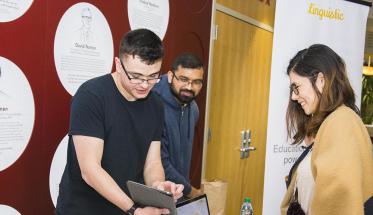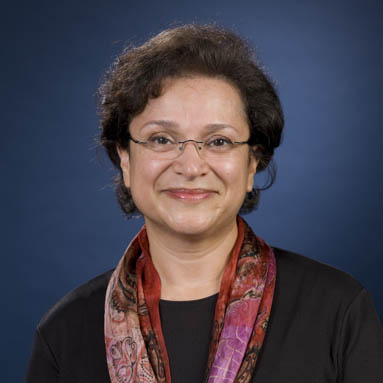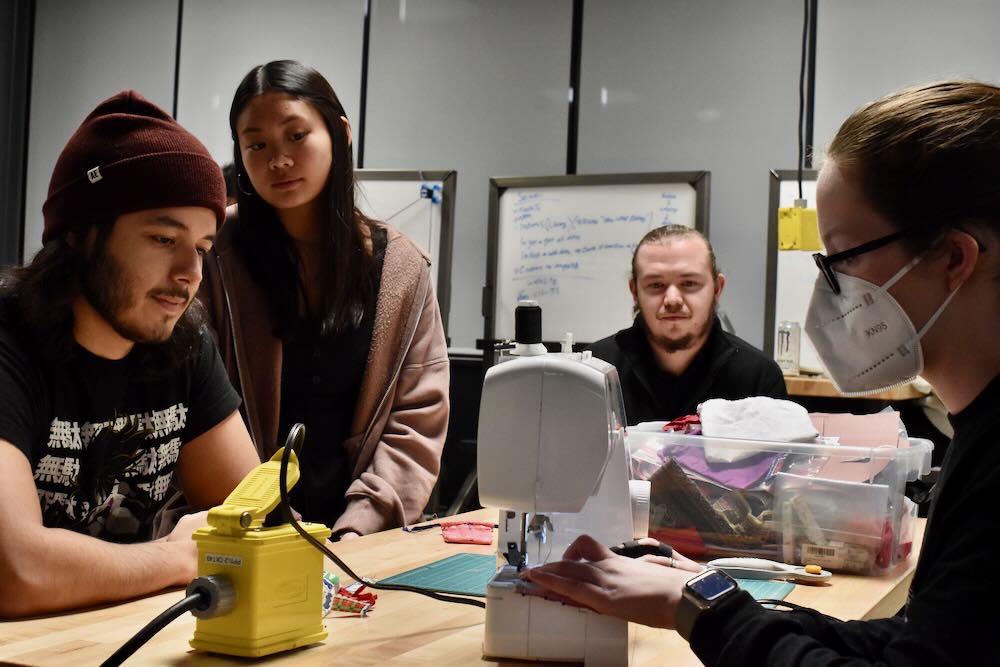An industry leader in the user experience and organizational decision-making field advised that his counterparts will have to strengthen partnerships with higher education to prepare the next generation for changing technologies, to further innovation, and to be successful as they enter the workforce.
“The collaboration between education and industry provides an opportunity to continue to drive innovation, and form programs for the next generation to become better aligned with what is needed in industry,” said Andy Piggott, vice president, user community, at Oracle.
“That is why initiatives like UXSYM are so important. Oracle gets tremendous value out of its relationship with UXSYM and WPI that helps us learn and innovate more quickly.”
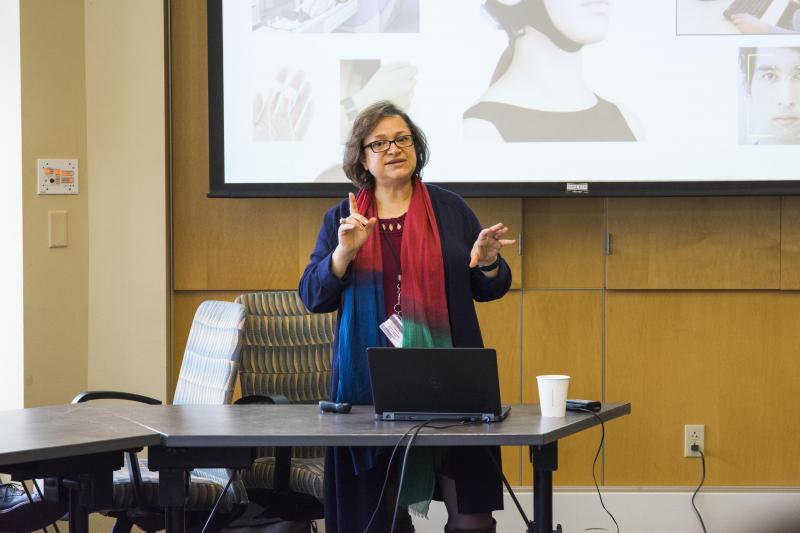
Soussan Djamasbi
Piggott made his remarks as afternoon keynote speaker at the April 19 UXSYM (User Experience Innovation Symposium) held in the Rubin Campus Center. The one-day conference was hosted by the university’s User Experience and Decision Making Laboratory and featured speakers and workshops focusing on innovations in user experiences.
The program also brought some alumni back to campus to showcase their own innovation.
Associate professor of management information systems and recent recipient of the Board of Trustees' Award for Academic Advising Soussan Djamasbi has grown the UX community on campus through UXSYM. The UXDM lab, established in 2011, conducts research with significant contributions to theory and practice while providing outstanding learning opportunities for WPI students. The UX lab launched its PhD program in 2014 and its first doctoral student just defended her dissertation earlier this month, Djamasbi said. It is launching a master’s degree program this fall and working on implementing a certificate program, she added.
One of the biggest announcements made by Djamasbi during her opening remarks at UXSYM is the expansion of WPI’s UXDM lab to include the Internet of Things.
Piggott told the audience that Oracle is hiring as the international company expands into integrated cloud applications. “A lot of things happening right now are causing widespread global change,” he said. “The innovation we have today is built around customers and built around improving experience. We have a responsibility today as user experience professionals to help us through this transition, through all these new technologies, to the way they are going to change the world that is going to improve many people’s experiences, but are going to present many, many new challenges.
“We need to work very hard with education to make sure we’re preparing that next generation for technologies that have changed, for innovating on top of them, and to be successful as they move into industry.
“That, for me—working with people like UXDM, and Soussan, particularly, here—is extremely powerful because we can help as part of this consortium, not just to drive research as we believe we need to spend time and effort getting behind, but to knowledge-share among ourselves.”
Morning session keynote speaker John Wyatt ’11, ’17 (MBA), research collaborator at Oracle, said studies conducted over the past six months alone show how much UX has changed and grown.
It is tough to get and retain new talent, Wyatt said, making Oracle’s collaboration with WPI key in helping shape the next generation of UX professionals. Organizers of last year’s event listened to feedback, he said, and made this year’s event more interactive with hands-on activities.
“We need to work very hard with education to make sure we’re preparing that next generation for technologies that have changed, for innovating on top of them, and to be successful as they move into industry. That, for me—working with people like UXDM, and Soussan, particularly, here—is extremely powerful because we can help as part of this consortium, not just to drive research as we believe we need to spend time and effort getting behind, but to knowledge-share among ourselves.” -Andy Piggott
Tyler Nickerson ’17, founder and CEO of Linguistic, had a demonstration of his language learning app set up at the event. He said he spoke with a lot of people at the event and enjoyed a good reception. “That is the mission—to get people excited about this work,” he said.
He said his immersive language-learning app gives users exposure to a foreign language through conversations with native speakers and to foreign media, including web articles and movies via artificial intelligence.
“As you communicate with native speakers on the platform," explained Nickerson, who started developing the app while at WPI and taking Mandarin classes, "the system automatically infers your proficiency level using artificial intelligence and reports back to you your matches with native speakers and recommends foreign media appropriate to your skill level.
“This is a culmination of what I’ve learned; it is a passion-driven and vision-driven product,” he continued. “Apart from really giving me computer science knowledge to tackle these problems, without my WPI education, I wouldn’t have been able to develop the techniques I’m using in the platform to make it work.”
He said that during his senior year at WPI he was allowed to focus on his passion and was able to conduct individual studies under the guidance of humanities and arts professor Jennifer Rudolph and computer science professor Michael Ciaraldi.
“Under Professor Ciaraldi I was able to do research on different types of technology, and under Professor Rudolph I conducted a feasibility study on Chinese customer-based markets for linguistics that were lacking in English language education and how linguistics tackles those problems. I had an extensive amount of school time during the day dedicated to linguistics that gave me time to do all that research.”
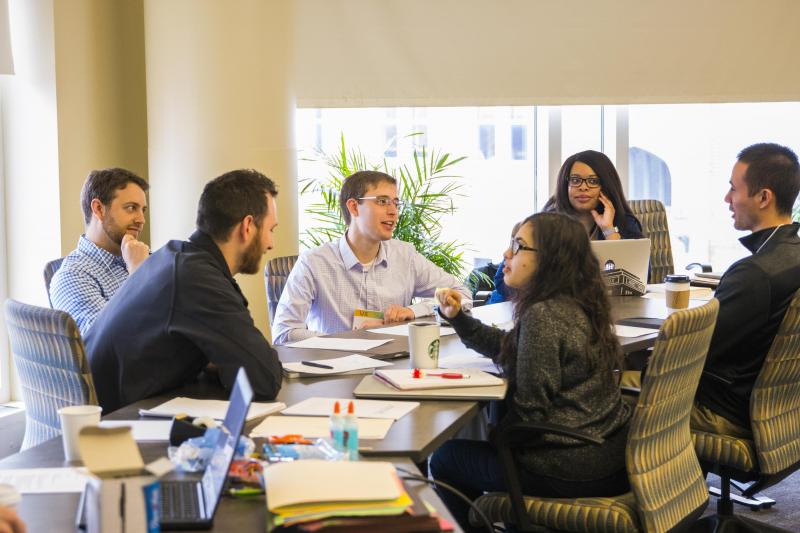
The symposium featured a networking break, poster
sessions, and panel discussions among participants.
Ryan Leaf ’17, founder and CEO of Minsilo communications platform, said he also received a lot of positive feedback and was excited about the symposium. “It is a great event,” he said.
UXSYM included a networking break, poster sessions, and panel discussion with Piggott, Tom Tullis (vice president of Usability and User Insight at Fidelity Investments), and Marguerite Bergel (vice president of the Boston Chapter of the User Experience Professionals’ Association).
Djamasbi said her projects in creating value with innovation is grounded in two research areas, Neuro Information System (NeuroIS) and User Experience Design (UXD). NeuroIS uses neurophysiological tools to better understand information processing and decision behavior; UXD uses design thinking and other user-centered frameworks to develop outstanding user experiences. Combining these two research areas has proven to be extremely successful in developing more effective decision support systems.
Talking to a group in a packed hall, Djamasbi said that in her research projects she uses subjective measures such as surveys, objective measures including performances on a task, and physiological measures such as heart-rate variability and eye-tracking, to study how people use a technology, how they process information they take in and how they make decisions based on the information they viewed. This data provides invaluable information for gaining insight into designing more effective and successful systems.
Speaking on eye tracking and user experience, she described it as an effective research tool to study user experiences because sight and eye movement are unconscious and it has the least impact on users who often forget they are part of a study. The eye tracker device measures eye positions and eye movement. Users are not tethered in eye tracking and do not have to wear cumbersome apparatus, she said. Eye tracking detects moment-by-moment gaze direction during website navigation or mobile app utilization “With eye tracking, nothing is attached to the user,” she said. “I’ve been doing this for 12 years and people forget and nothing is affected.”
Djamasbi explained that user experience research helps those in the industry understand a user’s point of view by allowing them to literally see via a user’s eyes. Serving as a valuable tool in technology design, particularly in software application design and development (e.g., website design), it helps researchers understand how they can improve the effectiveness and the experience of a technology for their users.
She explained how the human eye works, how eye tracking records what users register with their eyes, how what is registered with the eye can reveal information processing behavior, and how web design and other technologies can benefit from that data.
“It is an enhanced observation technique that can improve our understanding of what people are looking at to study social interactions and interactions with robots and displays,” Djamasbi said. When coders are able to see what the user sees, she said, they are able to change the “mindset” of believing use of their product is intuitive and that people “should know how to use it.
“When you have the users’ point of view, you can build that into the design,” she said. She added that the UXDM lab is also working on emotion tracking, using deep learning to follow facials expressions.
- By Paula Owen
